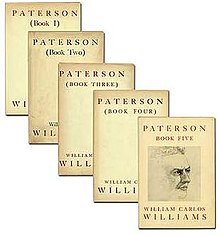
Paterson is an epic poem by American poet William Carlos Williams published, in five volumes, from 1946 to 1958. The origin of the poem was an eighty-five line long poem written in 1926, after Williams had read and been influenced by James Joyce's novel Ulysses. As he continued writing lyric poetry, Williams spent increasing amounts of time on Paterson, honing his approach to it both in terms of style and structure. While The Cantos of Ezra Pound and The Bridge by Hart Crane could be considered partial models, Williams was intent on a documentary method that differed from both these works, one that would mirror "the resemblance between the mind of modern man and the city."[1]
While Williams might or might not have said so himself, commentators such as Christoper Beach and Margaret Lloyd have called Paterson his response to T.S. Eliot's The Waste Land and Pound's Cantos. The long gestation time of Paterson before its first book was published was due in large part to Williams's honing of prosody outside of conventional meter and his development of an overall structure that would stand on a par with Eliot and Pound yet remain endemically American, free from past influences and older forms.
The poem is composed of five books and a fragment of a sixth book. The five books of Paterson were published separately in 1946, 1948, 1949, 1951 and 1958, and the entire work collected under one cover in 1963. A revised edition was released in 1992. This corrected a number of printing and other textual errors in the original, especially discrepancies between prose citations in their original sources and how they appeared in Williams's poem. Paterson is set in Paterson, New Jersey, whose long history allowed Williams to give depth to the America he wanted to write about, and the Paterson Falls, which powered the town's industry, became a central image and source of energy for the poem.[2]
- ^ Beach, Christopher (2003). The Cambridge introduction to twentieth-century American poetry (1st publ. ed.). Cambridge: Cambridge UP. pp. 109–16. ISBN 9780521891493.
- ^ MacGowan, Christopher (2003). William Carlos Williams: poetry for young people. New York: Sterling. p. 8. ISBN 9781402700064.